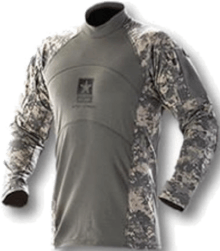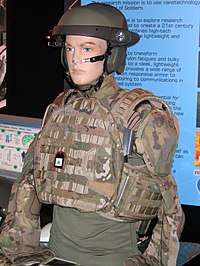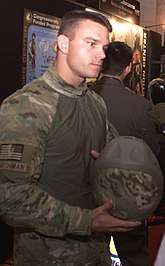Army Combat Shirt
| Army Combat Shirt | |
|---|---|
 An early model Army Combat Shirt in the Universal Camouflage Pattern (UCP). This particular model was worn primarily in 2007 and 2008; later models were made without the army logo on the chest. | |
| Type | Shirt |
| Place of origin | United States of America |
| Service history | |
| In service | 2007–present |
| Wars |
War in Afghanistan Iraq War |
| Production history | |
| Designed | 2004 |
| Manufacturer | Massif Mountain Gear[1][2] |
| Unit cost | 179.00$[3] |
| Produced | 2004–present |
| Variants | OCP ACS, MultiCam ACS, UCP ACS, Ballistic Combat Shirt |
The Army Combat Shirt (ACS) is a flame-resistant shirt developed and used by the United States Army as a supplementary addition to the Army Combat Uniform.[4] The ACS is a stand-alone shirt designed specifically for use with Improved Outer Tactical Vest armor in warm and hot weather instead of the blouse. It is intended to greatly increase user comfort through the use of lightweight, moisture-wicking, and breathable fabrics. The ACS was created in conjunction with the USMC's Flame Resistant Organizational Gear (FROG). The ACS, in conjunction with the Fire Resistant ACU (FRACU) trousers, provides head-to-toe protection against burns.
Background
Traditionally, flame-resistant uniforms have been reserved for military personnel such as aviators, fuel handlers and combat vehicle crew who were most likely to encounter fuel-related fires. However, the increasing frequency of improvised explosive devices in Afghanistan and Iraq during the 2000s greatly increased the number of troops in need of flame-resistant clothing and uniforms.
History
2000s
2004–2005: Development
Early prototype versions of the Army Combat Shirt in the MultiCam camouflage pattern were unveiled by the Army in July 2004 at a military technology convention held at the U.S. Capitol as a part of the Future Force Warrior program.[5]
A year later in June 2005, prototypes were again displayed during a Future Force Warrior convention at the U.S. Capitol.[6][7][8][9][10]
2007: Introduction
In January 2007, the Army began shipping 160,000 flame-resistant Nomex uniforms for soldiers assigned to at-risk convoy operations. However, the Nomex uniforms restricted air movement more than the traditional Cotton/Nylon ACU and were hotter for soldiers to wear. Army equipment officials developed the ACS to provide soldiers with a lightweight, breathable alternative to the Nomex ACU.
2010s
2016–2017: Ballistic Combat Shirt
Currently the U.S. Army is working on an armored variant of the Army Combat Shirt known as the "Ballistic Combat Shirt", which adds ballistic protection to the upper thorax, lower neck, and upper sleeve areas while sacrificing as little arm mobility as possible.[11] This has been desirable due to the increasing prevalence of low-profile body armor which does not support the additional extremity protection the IBA system does, as well as ergonomic issues with the extremity protection that causes soldiers to choose not to use them even when wearing compatible armor.
Overview
Initially, the torso of the shirt was foliage green with the Army Strong logo centered on the chest (removed in later versions); the arms are in the Universal Camouflage Pattern similar to the Army Combat Uniform, with integrated anti-abrasion elbow pads. No-seam shoulders minimize rubbing or chafing against armor. With the adoption of the MultiCam uniform for wear in Afghanistan, there is now a version made with a tan body and MultiCam sleeves. Other features include a double pen pocket on the lower arm, zippered storage pockets on the upper arm, concealable infrared identification tabs, and a place to attach name, rank, and flag on the upper arm.[4] The features of both shirts are the same.
The ACS is constructed of three flame-resistant performance fabrics proprietary to TenCate Protective Fabrics or Massif Mountain Gear Company. The shirt’s torso is constructed of two highly breathable flame-resistant fabrics with advanced moisture management capabilities. Both fabrics wick moisture away from the skin and dry rapidly, preventing the fabrics from sticking to the user’s skin and greatly increasing comfort under body armor. The sleeves and side panels of the shirt are constructed of a lightweight, but durable and abrasion-resistant fabric designed to provide extra protection for areas not protected by body armor. All three fabrics feature 4-way stretch for enhanced performance and user comfort.
See also
References
- ↑ Army Combat Shirt Interview The interview describes how the ACS protected a soldier from burn injuries in Afghanistan.
- ↑ "ARMY COMBAT SHIRT TYPE II (FR) - MASSIF®". www.massif.com.
- ↑ "FR Combat Shirts, Fire Resistant Combat Shirts - Massif Mountain Gear". www.massif.com.
- 1 2 Dawson, Debi (2007-05-04). "PEO Soldier to Unveil New Army Combat Shirt". Army.mil. Retrieved 2012-11-25.
- ↑ "Defense.gov News Article: Future Warrior Exhibits Super Powers". archive.defense.gov. July 2004.
- ↑ Daniel D. Turner (October 2005). "Future Force Warrior, Engineering Design Event Number 4" (PDF). Army Research Library. Archived from the original (PDF) on 2007-06-24.
- ↑ John H. Edwards. "Future Force Warrior Advanced Technology Demonstration Update" (PDF). NDIA International Infantry & Joint Services Small Arms Systems Annual Symposium. Archived from the original (PDF) on 2017-08-16.
- ↑ "Army's Future Force Warrior passes major milestone".
- ↑ Copeland, Phillip E. "Photo Archive". U.S. Department of Defense Transformation Official Website.
- ↑ "Army displays latest warfighting innovations". U.S. Army. June 2005. Archived from the original on 2005-06-18.
- ↑ GOARMY.COM (9 December 2016). "The Ballistic Combat Shirt: Overview" – via YouTube.
Further reading
- PEO Soldier to Unveil New Army Combat Shirt by Debi Dawson, 4 May 2007
- USMC Program Manager FROG brief
- New Fireproof Army Shirt More Breathable by Matthew Cox, 19 September 2007
- [Matthew Cox, "Stopping the Burn," Army Times, 7 May 2007]

